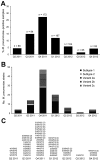Mycoplasma pneumoniae and Chlamydia spp. infection in community-acquired pneumonia, Germany, 2011-2012
- PMID: 25693633
- PMCID: PMC4344269
- DOI: 10.3201/eid2103.140927
Mycoplasma pneumoniae and Chlamydia spp. infection in community-acquired pneumonia, Germany, 2011-2012
Abstract
Mycoplasma pneumoniae and Chlamydia spp., which are associated with community-acquired pneumonia (CAP), are difficult to propagate, and can cause clinically indistinguishable disease patterns. During 2011-2012, we used molecular methods to test adult patients in Germany with confirmed CAP for infection with these 2 pathogens. Overall, 12.3% (96/783) of samples were positive for M. pneumoniae and 3.9% (31/794) were positive for Chlamydia spp.; C. psittaci (2.1%) was detected more frequently than C. pneumoniae (1.4%). M. pneumoniae P1 type 1 predominated, and levels of macrolide resistance were low (3.1%). Quarterly rates of M. pneumoniae-positive samples ranged from 1.5% to 27.3%, showing a strong epidemic peak for these infections, but of Chlamydia spp. detection was consistent throughout the year. M. pneumoniae-positive patients were younger and more frequently female, had fewer co-occurring conditions, and experienced milder disease than did patients who tested negative. Clinicians should be aware of the epidemiology of these pathogens in CAP.
Figures


References
-
- Polkowska A, Harjunpää A, Toikkanen S, Lappalainen M, Vuento R, Vuorinen T, et al. Increased incidence of Mycoplasma pneumoniae infection in Finland, 2010–2011. Euro Surveill. 2012;17:20072 . - PubMed
Publication types
MeSH terms
LinkOut - more resources
Full Text Sources
Other Literature Sources
Miscellaneous

